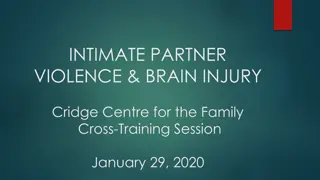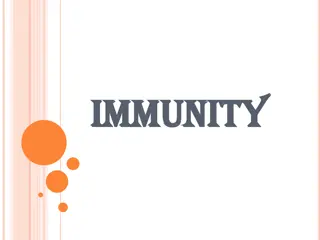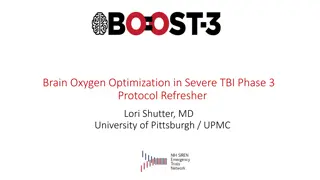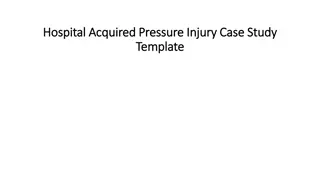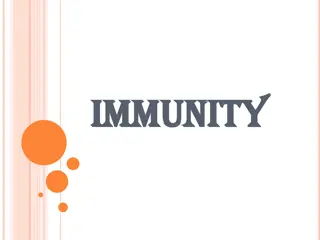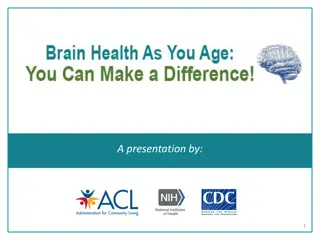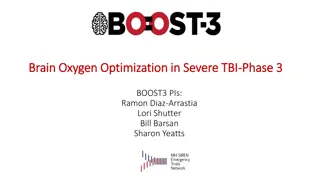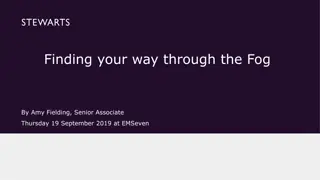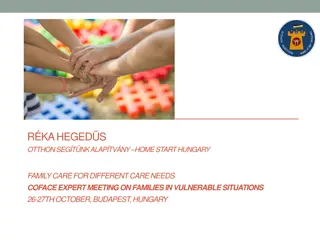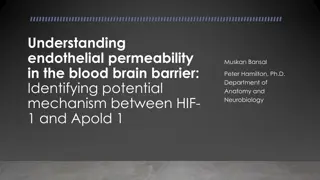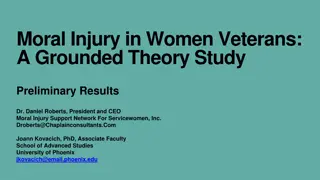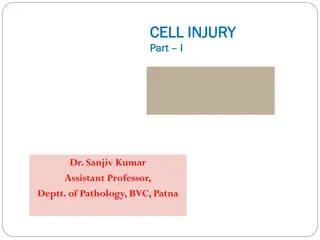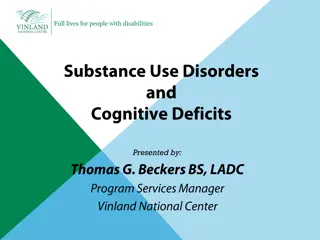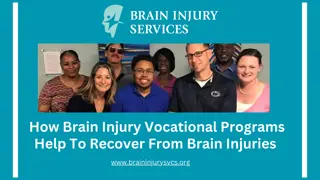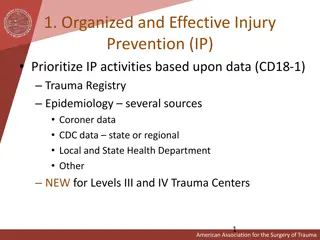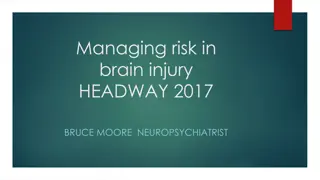Understanding the Impact of Acquired Brain Injury on Families
Acquired Brain Injury (ABI) can result from various causes like head trauma, stroke, or substance abuse, leading to emotional turmoil for both the individual affected and their family. A qualitative study highlights the challenges parents face in caring for a child with ABI, likening the experience to a form of grief. Parenting styles, coping mechanisms, and predictors of negative impact on families are crucial aspects addressed in this study, shedding light on the profound emotional and financial toll of ABI.
Download Presentation

Please find below an Image/Link to download the presentation.
The content on the website is provided AS IS for your information and personal use only. It may not be sold, licensed, or shared on other websites without obtaining consent from the author. Download presentation by click this link. If you encounter any issues during the download, it is possible that the publisher has removed the file from their server.
E N D
Presentation Transcript
Stepping Stones Triple P and Acceptance & Commitment Therapy for Acquired Brain Injury Felicity Brown PhD Candidate School of Psychology The University of Queensland, Australia
What is ABI? Any damage to the brain that has occurred after birth (AIHW, 2007;2008) Mechanisms of brain damage can include head trauma, stroke, hypoxia, degenerative neurological disease, tumors, or substance abuse or poisoning Approximately 20,000 Australian children under 15 have an ABI (ABS, 2003) greater and more global (Anderson et al., 2009) Lifetime costs per individual (Access Economics, 2009) $2.5 million for moderate TBI $4.8 million for severe TBI
It was just the most out of control, horrendous thing that s ever happened in my life (Mother) Qualitative study Brown, FL, Whittingham, K., Sofronoff, K., Boyd, R. Parenting a Child with a Traumatic Brain Injury: Experiences of Parents and Health Professionals , Brain Injury, [in review]
Impact of ABI I would suggest that it s nearly like going through death; watching somebody die. Personally, I think the emotions are very similar (Step-Father) He ll just lash out for no apparent reason...you re just on your guard all the time because you don t know what s going to happen. (Mother) (Catroppa & Anderson, 2009; Fay et al., 2009; Gerrard-Morris et al., 2010; Ganesalingam et al., 2008; Micklewright et al., 2012; Stancin et al., 2008; Taylor et al., 2001)
Role of Parenting Authoritarian traits Warmth Negativity Scaffolding Permissiveness After you ve seen your child like that, you re not going to hurt them more, are ya? (Mother) (Gerrard-Morris et al., 2010; Kurowski et al., 2011; Micklewright et al., 2012; Potter et al., 2011; Wade et al., 2011; Yeates et al, 2010)
Predictors of negative impact on family Pre-injury functioning Injury severity Child deficits and behaviour Perception of met needs Interpersonal stressors and resources Material resources (SES) Parental coping Style Denial/disengagement Active-coping (for severe TBI but not mild or orthopaedic injury) Seeking social support for emotional coping Acceptance Use of humour
Limited research trialling family interventions in this population I think it is a harder slog with kids with brain injury . more repetition for a longer period, in more contexts . you never get those .. golden responders to the behaviour management that you do see in normal families (Health Professional) Systematic review Brown, FL, Whittingham, K., Boyd, R., Sofronoff, K. A Systematic Review of Parenting Interventions for Traumatic Brain Injury: Child and Parent Outcomes, Journal of Head Trauma and Rehabilitation, 2012 May 28 [Epub ahead of print]
ABI brings unique challenges compared to other disabilities One thing that stood out for me was when they behave in a certain way .. you flashback to the time of the accident, constantly .. it s back to the trauma, every time. (Mother)
Parents can often be so engaged in doing everything they can for their child, they forget to look after themselves. And so there needs to be some discussion around that, and relaxation strategies or time out for themselves so they are able to continue caring for their child.. (Health Professional)
Acceptance and Commitment Therapy for Parenting Stress Targets parental stress and adjustment Incorporates mindfulness and acceptance of emotional and cognitive responses in service of valued living ACT has been found to decrease distress in parents of children with autism (Blackledge & Hayes, 2006) Preliminary evidence from studies at UQ 2 x 2 hour session workshop
Stepping Stones Triple P Positive Parenting Program Triple P - Efficacy demonstrated through 4 independent meta-analyses (de Graaf et al., 2008a;2008b; Thomas & Zimmer-Gembeck, 2007; Nowak & Heinrichs, 2008) Stepping Stones is a new variant of Triple P, specifically for parents of children with disabilities. It has demonstrated positive outcomes in child behavioural and emotional outcomes in mixed samples and in children with ASD (Plant & Sanders, 2007; Roberts et al., 2006; Whittingham et al., 2009; Sofronoff et al., 2011)
Sessions cover Principles of positive parenting Developing positive relationships Encouraging desirable behaviour Teaching new skills and behaviours Managing misbehaviour Parenting plans for high risk situations Planning for the future 6 x 2 hour group sessions, 3 x 30 minute individual phone calls
I wanted to meet other people... I wanted to meet someone else who sort of got it instead of, just doctors... it's like what do you know? ... Like you know, you can tell me what you've heard, but you can't tell me what the real deal is. Like, you know, someone else that feels it (Mother) Group format chosen Conducted by intern psychologists at University of Queensland Free of charge Offered at a variety of times and locations Make-up sessions offered when parents unable to attend group session.
We hypothesised that relative to the waitlist control group, the treatment group would demonstrate improvements on: Child behavioural and emotional functioning Parenting style Parental adjustment Parental confidence Family functioning Relationships between parents Parent psychological flexibility
Sample Inclusion criteria: Parents of children 2-12 y.o. with ABI Parents report behavioural or emotional difficulties Injury sustained at least 3 months prior Parents have effective communication in English Exclusion criteria Child still acutely unwell Child has degenerative neurological condition Child lives with foster family
CONSORT flow chart Potentially eligible parents identified and attempt made to contact (n=385) Self-referred or clinician referred parents (n=8) Could not contact (n= 56) Contacted and conducted screening call (n= 337) Not eligible (n=127) Eligible (n= 210) Declined participation (n= 151) Baseline: (T1) (n = 59) Randomisation Allocated to Waitlist (n = 29) Allocated to Treatment (n = 30) Did not complete T2 Too busy (n= 2) Did not complete program Illness in family (n=2) Separation (n= 2) Too far to travel (n=1) Treatment Did not commence program Times unsuitable (n=3) Tumor recurrence (n=1) Moved away (n=1) Post-treatment: (T2) (n=25) Post-waitlist: (T2) (n= 27) Treatment Did not complete program Too busy (n=4) Unknown (n=2) Post-treatment: (T3) (n=16) Lost to follow up: Reason unknown (n=4) Lost to follow up: Reason unknown (n=4) 6 month follow up: (T4) (n= 12) 6 month follow up: (T4) (n= 12)
Statistical Approach Compared baseline variables ( 2, t-tests) Analysis of factors predicting participation (logistic regression) Analysis of factors predicting drop-out (logistic regression) Mixed-Model Repeated Measures regressions on intent-to-treat sample Uses maximum likelihood methods, rather than sum of least squares Time and treatment as categorical fixed factors, subject as random factor. Post treatment to 6 month follow up (collapsed between groups) (equal variance-covariance structure assumed, sattherthwaite approximation for denominator df) MMRM conducted post-intervention to 6-month follow up collapsing over groups (small sample sizes at 6-months) p < 0.05 reported as significant- due to a-priori hypotheses. Effect sizes presented as Cohen s d Reliable change and clinical significance calculated
Treatment (n=30) Waitlist (n=29) Age at baseline, M (SD) 7.13 (3.17) 6.87 (3.03) Time since injury, M (SD) 3.13 (2.62) 3.63 (2.52) Male, N (%) 17 (57) 18 (62) Caucasian, N (%) 26 (87) 26 (90) Cause of ABI, N (%) TBI 21 (70) 13 (45) 9 (30) 16 (55) ABI Other diagnoses, N (%) Intellectual Impairment 2 (7) 3 (10) * Learning difficulties 18 (60) 9 (31) Autism spectrum disorders 2 (7) 0 (0) ADHD 2 (7) 1 (3)
Treatment (n=30) Waitlist (n=29) Relationship to child, N (%) Mother (1 custodial GM in Treat) Father Relationship status, N (%) Married/ defacto Separated/divorced/Widowed 27 (90) 3 (10) 26 (90) 3 (10) 18 (60) 12 (40) 27 (93) 2 (7) * Participating parent's employment, N (%) Full-time Part-time Home-duties/Unemployed 13 (43) 5 (17) 12 (40) 4 (14) 9 (31) 16 (55) * Family annual income (AUD), N (%) < $25 000 $25 000 to $50 000 $50 000 to $75 000 > $75 000 7 (23) 4 (13) 6 (20) 13 (43) 4 (14) 3 (10) 9 (31) 13 (45)
Did participation in the program improve child behavioural and emotional outcomes relative to waitlist?
ECBI- Intensity ECBI- Problems (Error Bars: +/- 1 SD) d= 0.90 : -30.06 d= 0.76 : -6.49 t (52.11)= -4.51, p<.001 6-months- NS t (52.54)= -2.80, p=.007 6-months- NS 32% demonstrated reliable and clinically significant change.
SDQ- Emotional d= 0.50 : -1.32 t (51.43)= 2.32, p= .025 6-months- Significant increase. d= -0.18
Did participation in the program reduce dysfunctional parenting practices relative to waitlist?
Laxness Over-reactivity d= 0.76 : -0.74 d= 0.54 : -0.39 t (52.58)= -4.00, p<.001 6-months- NS t (52.45)= -2.25, p=.029 6-months- NS
Did participation in the program improve parental adjustment relative to waitlist?
Depression Anxiety and Stress Scale (Lovibond and Lovibond, 1995)
Depression Anxiety d= 0.39 : -2.98 d= 0.24 : -2.29 t (52.58)= -4.00, p=.039 6-months- NS t (51.21)= -1.06, p=.297 6-months- NS
Stress d= 0.56 : -4.77 t (50.88)= -2.20, p=.032 6-months- NS
Did participation in the program improve parental psychological flexibility (a.k.a. experiential acceptance) relative to waitlist?
AAQ for ABI Rated 1 (never true) to 7 (always true), = .78
AAQ (ABI) d= 0.74 : 11.80 t (51.98)= 3.34, p=.002 6-months- Significant decrease, d= -0.29
Satisfaction with program 15 item satisfaction questionnaire Scored 1 to 7 Average Score = 6 Would you recommend ACT to other parents? Average = 6 Was ACT helpful for you? Average = 6
Which program would you prefer? Stepping Stones Stepping Stones & ACT ACT
Greatly improved my awareness in what part I play in my child's behaviour.. I feel empowered and have increased confidence in my parenting abilities.. I liked the "support group" aspect of the program and feeling like I'm not alone. I really got a lot out of the stress management sessions- could do a whole program just on that. (Dad) I liked the centred, being in the moment attitude (Mum)
Effect of ACT? Mediation analysis conducted Question 1: a) At baseline, was AAABIQ correlated with psychological well-being? b) At baseline, was AAABIQ correlated with parenting style? Measure Depression Anxiety Stress Laxness Over-reactivity Correlation AAABIQ - .619 ** - .420 ** - .574 ** - .345 ** - .210 Note, * p<.05, **p<.01 small = 0.1, medium = 0.3, large = 0.5
Question 2: a) Did change on AAABIQ mediate change on depression, anxiety and stress? Change AAABIQ ? a path, p= .001 b path, p= .003 ? Change stress Treatment C path, p= .03 C path, p= .38 Using boot strapping for indirect effects: 95% CI: -6.94, -0.55
Question 3: a) Did change on AAABIQ and/or DASS mediate change on laxness and over- reactivity? Change AAABIQ a path, p= .001 b path, p= .01 ? ? Change over-react Treatment C path, p= .02 C path, p= .38 ? a path, p= .06 b path, p= .14 Change DASS ? Using boot strapping for indirect effects on AAABIQ : 95% CI: -0.45, -0.05 DASS not significant
CAUTION! In order to assess mediation, proposed mediators should be measured prior to the outcome We lack temporal precedence These results should be interpreted as very preliminary.
Summary/ Discussion High satisfaction reported by parents, quantitative results appear to support efficacy of program BUT Future Research: Efficacy vs. effectiveness? Unique effects of ACT and Triple P? Online delivery? Mediational analyses should be conducted measuring psychological flexibility prior to measuring outcomes.
Stepping Stones TBI Project Team: Supervisors: A/Prof Kate Sofronoff Dr Koa Whittingham Prof Roslyn Boyd Dr Lynne McKinlay, Mr Owen Lloyd and Dr Valda Biezaitis Parents and professionals who participated in focus groups and RCT RCH and Mater staff for recruitment support Funding: UQ Graduate School International Travel Award QCMRI Science PhD Scholarship- funded by Golden Casket Research support from Parenting and Family Support Centre and QCPRRC
Criteria Mild TBI GCS 13-15 LOC <30 minutes PTA < 1hr +/- simple skull fracture (eg. Linear, non-depressed) Mild Complicated TBI As above + changes on cerebral imaging not needing neurosurgery Moderate TBI LOC 30-60 minutes GCS 9-12 PTA 1-24 hours OR any neurosurgical intervention Severe TBI LOC>60 minutes PTA > 24 hours GCS< 9




